Viz Specifikace pro podrobnosti o produktu.

BAS70,215 Diode: Product Overview and Specifications
Introduction
The BAS70,215 diode is a crucial component in the field of electronics, known for its versatile applications and unique characteristics. This entry provides an in-depth analysis of the BAS70,215 diode, covering its product details, specifications, pin configuration, functional features, advantages, disadvantages, working principles, application fields, and alternative models.
Product Overview
Category
The BAS70,215 diode falls under the category of small signal Schottky diodes.
Use
It is commonly used in various electronic circuits for rectification, signal demodulation, and voltage clamping.
Characteristics
- Low forward voltage drop
- Fast switching speed
- High reliability
- Miniature SOT23 plastic package
Package
The BAS70,215 diode is typically available in a SOT23 package.
Essence
This diode serves as a key component in electronic circuits, enabling efficient signal processing and voltage regulation.
Packaging/Quantity
It is usually supplied in reels or tape and reel packaging, with varying quantities based on the manufacturer's specifications.
Specifications
- Maximum repetitive peak reverse voltage: 70V
- Average rectified current: 215mA
- Forward voltage: 0.32V at 1A
- Reverse leakage current: 2µA at 25°C
Detailed Pin Configuration
The BAS70,215 diode has three pins: 1. Anode 2. Cathode 3. Not connected (NC)
Functional Features
- Efficient rectification of low voltage signals
- Rapid switching capabilities
- Minimal power dissipation
- Compact form factor
Advantages and Disadvantages
Advantages
- Low forward voltage drop reduces power loss
- Fast switching speed enhances circuit performance
- Small package size enables space-efficient designs
Disadvantages
- Limited maximum reverse voltage compared to other diode types
- Higher forward voltage compared to standard silicon diodes
Working Principles
The BAS70,215 diode operates based on the Schottky barrier principle, where the metal-semiconductor junction allows for fast switching and low forward voltage drop.
Detailed Application Field Plans
Signal Demodulation
The BAS70,215 diode is widely used in radio frequency (RF) circuits for demodulating amplitude-modulated (AM) signals.
Voltage Clamping
In voltage clamping circuits, this diode effectively limits the peak voltage levels, protecting sensitive components from overvoltage damage.
Rectification
Due to its low forward voltage drop, the BAS70,215 diode is ideal for rectifying low voltage AC signals in various electronic devices.
Detailed and Complete Alternative Models
- 1N5711: A comparable Schottky diode with similar characteristics
- BAT54S: Another SOT23-packaged Schottky diode suitable for similar applications
In conclusion, the BAS70,215 diode offers a balance of performance and compactness, making it a preferred choice for diverse electronic applications requiring efficient signal processing and voltage regulation.
Word count: 464
Seznam 10 běžných otázek a odpovědí souvisejících s aplikací BAS70,215 v technických řešeních
What is BAS70,215?
- BAS70,215 is a dual common cathode switching diode array commonly used in electronic circuits for signal switching and protection.
What are the typical applications of BAS70,215?
- BAS70,215 is commonly used in applications such as signal switching, high-speed switching, and voltage clamping in various electronic circuits.
What is the maximum forward voltage of BAS70,215?
- The maximum forward voltage of BAS70,215 is typically around 0.715V at a forward current of 100mA.
What is the reverse voltage rating of BAS70,215?
- BAS70,215 has a reverse voltage rating of around 70V.
Can BAS70,215 be used for high-frequency applications?
- Yes, BAS70,215 is suitable for high-frequency applications due to its fast switching characteristics.
What is the package type of BAS70,215?
- BAS70,215 is typically available in a SOT-23 surface mount package.
Is BAS70,215 RoHS compliant?
- Yes, BAS70,215 is RoHS compliant, making it suitable for use in environmentally friendly electronic products.
What are the temperature specifications for BAS70,215?
- BAS70,215 is typically rated for operation over a temperature range of -55°C to 125°C.
Can BAS70,215 be used for voltage clamping applications?
- Yes, BAS70,215 is commonly used for voltage clamping to protect sensitive components from voltage spikes.
Are there any recommended alternative components to BAS70,215?
- Some alternative components to BAS70,215 include 1N4148, 1N914, and BAV99, which can be used based on specific application requirements.

